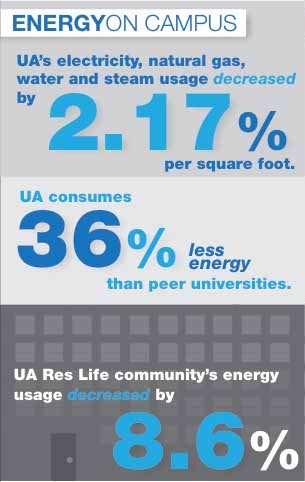The University of Alabama is set to meet its goal of annually reducing energy usage by two percent per gross square footage of building space, despite pressure from facility and population growth.
Greg McKelvey, director and UA energy manager, said the University has historically rated No. 1 in its peer group, as determined by Sightlines, LLC, an independent organization that compiles universities into groups of similar type and benchmarks their energy performance.
The two percent reduction goal has been met every year since it was set. McKelvey said it was not meant to be an easy goal, and the department believes it can continue to meet it.
“We wanted to establish a goal that was a reach – that resulted in us pushing ourselves [but was also] obtainable,” he said.
According to a report provided by Facilities Operations, the University used 36 percent less energy than peer universities during the 2012 fiscal year.
“During the past 12 months, UA accomplished an overall campus energy intensity reduction of 2.17 percent, which exceeded the annual reduction goal of 2 percent,” the report said.
McKelvey said good, comprehensive policies contributed to a cost avoidance of $6 million, something that students can notice in their own pocketbooks.
“Obviously, spending twenty million dollars a year for energy is a huge cost to the University,” McKelvey said. “Anything we can do to lower the energy costs lowers the operating cost of campus, which allows us to maintain lower tuition, allows us to have money for upgrading the existing buildings.”
Clint Fikes, associate university energy manager, and McKelvey said automation systems, building retrofitting and the completion of an East Quad Energy Plant were all factors contributing to the University’s high performance.
McKelvey said ongoing projects that will help the University meet its goals in the future, include expansion of LED lighting, installation of smart meters and “retro-commissioning,” the recalibration of buildings and their systems to help the buildings efficiently meet needs they may not have originally been built to accommodate.
Students help drive university energy management with population growth forcing buildings to stay open longer and new buildings exerting more strain on the system. New research buildings, in particular, are energy intense because they have particular air circulation needs.
“[There] are still many challenges and opportunities for improvement,” the 2012 report read. “[Additional] energy reduction strategies must be implemented in order to maintain our current levels of energy conservation effectiveness.”
McKelvey said students can contribute by being aware of their own energy consumption habits. Last year’s energy consumption competition between residence halls resulted in an 8.6 percent reduction of residential energy usage.
“They saw a significant energy reduction just by making people aware of doing things such as turning out lights, turning out TVs and systems when they’re not in the room,” McKelvey said. “All of this really adds up over the course of time. Things of that nature really make a difference when you’re on a campus of this size.”
Philip Shimel, a sophomore involved in the Sustainable Investment Project, said promoting and participating in a green fund can be a way for students to further drive sustainability efforts.
“Students today are already glimpsing the world we’re about to inherit,” Shimel said. “As college students at an energy-intensive school, we are particularly well-placed to voice a response.”
Shimel said Recycle Bama and Bama Bike programs are signs that the University is already paying attention to sustainability.
“Much of our University’s goals fall to us,” Shimel said. “Our University has the capacity to invest in energy production and savings right here on campus, but it has to let loose the creativity and drive of its populace. With such knowledgeable faculty and optimistic students, it’s hard to envision a better resource for positive improvements. Through SIP and other initiatives, the school should open itself to a variety of solutions coming from a variety of people.”
On the Facilities Operations front, Fikes said preventative maintenance and smart buying choices can ensure what the University has operates at maximum efficiency.
“I think a lot of places go after the bells and whistles and miss the basics,” Fikes said. “I think a good job has been done here at the University of looking at the whole picture [and] not overlooking the tedious daily tasks that are necessary to maintain things.”









